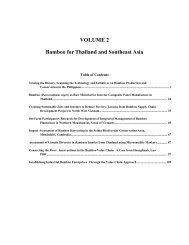WBC-VIII-Vol.4 – Resources – Forestry, Plantations and ... - BambuSC
WBC-VIII-Vol.4 – Resources – Forestry, Plantations and ... - BambuSC
WBC-VIII-Vol.4 – Resources – Forestry, Plantations and ... - BambuSC
Create successful ePaper yourself
Turn your PDF publications into a flip-book with our unique Google optimized e-Paper software.
inventory of harvestable volume <strong>and</strong> distribution of st<strong>and</strong>ing stock, appropriate harvesting methods, <strong>and</strong> on<br />
propagation as well as development <strong>and</strong> management of plantations.<br />
Introduction<br />
Bamboo is one of the most versatile <strong>and</strong> economically important forest products. It contributes to the<br />
subsistence needs of over a billion people in rural communities throughout the world. Among its traditional<br />
uses include fuel, wood, medicine, shelter, agricultural tools, <strong>and</strong> containers, hunting <strong>and</strong> fishing gear <strong>and</strong> other<br />
items for household purposes. Its processing <strong>and</strong> utilization for industrial products also play a vital role in<br />
livelihood <strong>and</strong> economic development in rural <strong>and</strong> urban areas. These include production of pulp <strong>and</strong> paper,<br />
housing <strong>and</strong> building construction materials as well as furniture <strong>and</strong> h<strong>and</strong>icrafts. However, such products are<br />
processed mainly from erect-type bamboos. Scanty information is available on the domestic or industrial<br />
utilization of climbing bamboos.<br />
This paper presents a perspective on the existing status of the resource as well as R&D breakthroughs <strong>and</strong><br />
needed directions to enhance the utilization of climbing bamboos in the country.<br />
Description Status of the Resource<br />
Based on rhizome structure bamboo is classified as sympodial <strong>and</strong> monopodial (Rojo et al 2000). The former<br />
has several culms per clump while the latter is single-stemmed. Morever, the growth habit of the culms can be<br />
classified into erect <strong>and</strong> climbing type.<br />
A climbing type can be easily distinguished from an erect bamboo by having crooked or zigzag culms with<br />
relatively small diameter (1-5 cm) which grow to considerable height <strong>and</strong> bear many branches at the nodal<br />
portion. The dominant branch may grow to the same diameter as the main culm forming ramified crown<br />
structures that cannot st<strong>and</strong> upward (Escobin et al 2005). Thus, they climb nearby trees for mechanical support<br />
above the ground or scramble over sloping ground or up rocky slopes <strong>and</strong> creek embankments in the forests.<br />
Number of species <strong>and</strong> distribution<br />
Rojo (1996) listed only 14 climbing bamboo species in the Philippines based on available literature. Recent<br />
botanizing activities by Escobin et al (as cited) reported the existence of 16 species under three genera:<br />
Dinochloa (8 spp.); Cyrtochloa (7 spp); <strong>and</strong> Cephalostachyum (1 sp).<br />
The Dinochloa species are the “true” climbers while Cyrtochloa <strong>and</strong> Cephalostachyum species have scrambling,<br />
trailing or clambering culms. Two of the 16 identified species are commonly found in the Philippines <strong>and</strong><br />
Borneo. The rest are endemic or found only in the country (Table 1). They grow gregariously whenever found<br />
from low altitude to 800 m above sea level. Most species have restricted distribution or are found only in a<br />
particular locality/province. However, D. luconiae <strong>and</strong> D. acutiflora occur throughout the Philippines.<br />
<strong>VIII</strong> World Bamboo Congress Proceedings Vol 4-26




